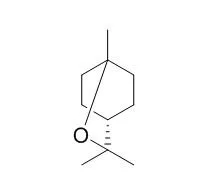| Description: |
Cineole has antihypertensive,and anti-inflammatory effects, it regulates nitric oxide and oxidative stress in rats chronically exposed to nicotine. Cineole can attenuate cerulein-induced AP via an anti-inflammatory mechanism and by combating oxidative stress, may can treat neurodegenerative disease.
|
| Targets: |
NF-kB | TNF-α | IL Receptor | NOS | COX | Beta Amyloid | ROS | NO |
| In vitro: |
| Food Addit Contam Part A Chem Anal Control Expo Risk Assess. 2012;29(3):415-22. | | In vitro antifungal activity of terpinen-4-ol, eugenol, carvone, 1,8-cineole (eucalyptol) and thymol against mycotoxigenic plant pathogens.[Pubmed: 22257275] | The aim of this study was to examine the effect of five naturally occurring compounds from essential oils on 10 different species of mycotoxigenic fungi involved in several plant diseases.
METHODS AND RESULTS:
The antifungal activities of terpinen-4-ol, eugenol, carvone, Cineole (eucalyptol) and thymol were observed in vitro on Fusarium subglutinans, Fusarium cerealis, Fusarium verticillioides, Fusarium proliferatum, Fusarium oxysporum, Fusarium sporotrichioides, Aspergillus tubingensis, Aspergillus carbonarius, Alternaria alternata and Penicillium sp. The naturally occurring compounds tested showed toxic effects on in vitro mycelium growth of all fungal species but with different level of potency.
CONCLUSIONS:
The results are encouraging for further investigations of in planta antifungal activities of these essential oils components. | | J Pharmacol Exp Ther . 2016 Mar;356(3):549-62. | | Noncompetitive Inhibition of 5-HT3 Receptors by Citral, Linalool, and Eucalyptol Revealed by Nonlinear Mixed-Effects Modeling[Pubmed: 26669427] | | Abstract
Citral, eucalyptol, and linalool are widely used as flavorings, fragrances, and cosmetics. Here, we examined their effects on electrophysiological and binding properties of human 5-HT3 receptors expressed in Xenopus oocytes and human embryonic kidney 293 cells, respectively. Data were analyzed using nonlinear mixed-effects modeling to account for random variance in the peak current response between oocytes. The oils caused an insurmountable inhibition of 5-HT-evoked currents (citral IC50 = 120 μM; eucalyptol = 258 μM; linalool = 141 μM) and did not compete with fluorescently labeled granisetron, suggesting a noncompetitive mechanism of action. Inhibition was not use-dependent but required a 30-second preapplication. Compound washout caused a slow (~180 seconds) but complete recovery. Coapplication of the oils with bilobalide or diltiazem indicated they did not bind at the same locations as these channel blockers. Homology modeling and ligand docking predicted binding to a transmembrane cavity at the interface of adjacent subunits. Liquid chromatography coupled to mass spectrometry showed that an essential oil extracted from Lippia alba contained 75.9% citral. This inhibited expressed 5-HT3 receptors (IC50 = 45 μg ml(-1)) and smooth muscle contractions in rat trachea (IC50 = 200 μg ml(-1)) and guinea pig ileum (IC50 = 20 μg ml(-1)), providing a possible mechanistic explanation for why this oil has been used to treat gastrointestinal and respiratory ailments. These results demonstrate that citral, eucalyptol, and linalool inhibit 5-HT3 receptors, and their binding to a conserved cavity suggests a valuable target for novel allosteric modulators. |
|
| In vivo: |
| Life Sci. 2013 Jul 10;92(24-26):1195-201. | | 1,8-cineole (eucalyptol) ameliorates cerulein-induced acute pancreatitis via modulation of cytokines, oxidative stress and NF-κB activity in mice.[Pubmed: 23702424] | Acute pancreatitis (AP) is an inflammatory condition wherein pro-inflammatory mediators, oxidative stress, and NF-κB signaling play a key role. Currently, no specific therapy exists and treatment is mainly supportive and targeted to prevent local pancreatic injury and systemic inflammatory complications. This study was aimed to examine whether 1,8-Cineole, a plant monoterpene with antioxidant and anti-inflammatory properties could ameliorate cerulein-induced acute pancreatitis.
METHODS AND RESULTS:
AP was induced in Swiss mice by six one hourly injections of cerulein (50 μg/kg, i.p.). 1,8-Cineole (100, 200 and 400mg/kg, p.o.) was administered 1h prior to first cerulein injection, keeping vehicle and thalidomide treated groups as controls. Blood samples were taken 6-h later to determine serum levels of amylase and lipase, and cytokines. The pancreas was removed for morphological examination, myeloperoxidase (MPO) and malondialdehyde (MDA) assays, reduced glutathione (GSH) levels, and for nuclear factor (NF)-κB immunostaining.
1,8-Cineole effectively reduced the cerulein-induced histological damage, pancreatic edema and NF-κB expression, levels of MPO activity and MDA, and replenished the GSH depletion. Cerulein increased serum levels of amylase and lipase, and pro-inflammatory cytokines TNF-α, IL-1β, and IL-6 were also decreased by 1,8-Cineole pretreatment, similar to thalidomide, a TNF-α inhibitor. The anti-inflammatory IL-10 cytokine level was, however, enhanced by 1,8-Cineole.
CONCLUSIONS:
These findings indicate that 1,8-Cineole can attenuate cerulein-induced AP via an anti-inflammatory mechanism and by combating oxidative stress. Further studies are needed to clearly elucidate its benefits in patients on acute pancreatitis. |
|






 Cell. 2018 Jan 11;172(1-2):249-261.e12. doi: 10.1016/j.cell.2017.12.019.IF=36.216(2019)
Cell. 2018 Jan 11;172(1-2):249-261.e12. doi: 10.1016/j.cell.2017.12.019.IF=36.216(2019) Cell Metab. 2020 Mar 3;31(3):534-548.e5. doi: 10.1016/j.cmet.2020.01.002.IF=22.415(2019)
Cell Metab. 2020 Mar 3;31(3):534-548.e5. doi: 10.1016/j.cmet.2020.01.002.IF=22.415(2019) Mol Cell. 2017 Nov 16;68(4):673-685.e6. doi: 10.1016/j.molcel.2017.10.022.IF=14.548(2019)
Mol Cell. 2017 Nov 16;68(4):673-685.e6. doi: 10.1016/j.molcel.2017.10.022.IF=14.548(2019)